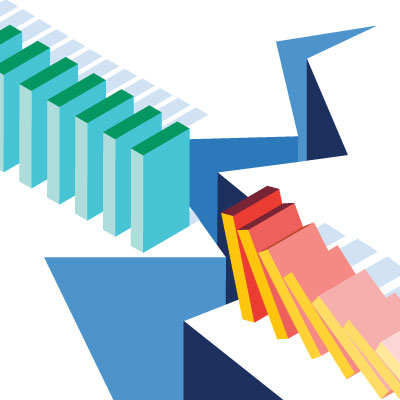The impact of earthquakes is relatively local, but the tsunamis they can generate may cause devastation far away. May 9 marks the anniversary of a massive earthquake in 1877 off the coast of what is today southern Chile (then part of Bolivia). Estimates of the quake’s magnitude vary around M8.5, but some are as high as M9.0. The mainshock struck at 9:16 p.m. local time and shaking was felt for five minutes in the coastal town of Caleta Pabellón de Pica 43 miles south of the port city of Iquique for which the earthquake is named. Iquique was devastated by the quake and significant damage was caused over coastal portions of the Tarapacá and Antofagasta regions.
More than 300 miles of the coast was struck by waves 33 feet high from a tsunami triggered by the 1877 earthquake. Water penetrated as far inland as the cathedral in the city of Arica, where eight separate tsunami waves came ashore. As well as damaging coastal property in Peru and northern Chile the tsunami affected coasts around the Pacific Ocean including those of Australia, New Zealand, Samoa, Tonga, Fiji, Hawaii, Mexico, California, and Japan; more than 2,000 people died in Fiji and five lives were lost in Hawaii.
Tsunamis can travel extraordinary distances; an earthquake off the coast of Chile in April 2014, for example, initiated a tsunami that reached New Zealand (Figure 1). The tsunami triggered by the massive December 26, 2004, M9.1 earthquake off the coast of Sumatra, for example, caused damage all around the Indian Ocean and cost more than 230,000 lives. The first waves struck Banda Aceh on the northern tip of Sumatra 20 minutes after the mainshock (or rupture nucleation), destroying much of the city and killing more than 100,000 inhabitants. And as the tsunami propagated away from Sumatra it struck in succession the coastal provinces of Phang Nga and Phuket in Thailand, the Indian coast near the southeastern city of Chennai, the island of Sri Lanka, and more. The last lives were lost in South Africa, 5,000 miles from the quake’s epicenter, when the tsunami arrived there nearly 8 hours after the mainshock that initiated it.
How a Tsunami Is Caused
Tsunamis generally form when a subduction earthquake occurs under the ocean. As one tectonic plate moves under another, part of the overlying plate is pulled downward, (due to frictional locking), instead of smoothly sliding past. This process, much like the loading of a spring, builds the potential energy that can generate a tsunami; at some point, the tension becomes so great that the plate interface ruptures at or near the fault. The plate's sudden deformation in turn generates the tsunami. How high, how rapidly, and how much water it displaces depends on the rupture characteristics of the event, particularly magnitude and shallow slip, but also including how abruptly the slip occurs and how deep it is under the ocean floor. The differential deformation propagates outward in all directions, which is why earthquakes that occur just off the coast of Japan or in Indonesia can affect the west coasts of North and South America.
Wavelength and Ocean Depth
Typically, the wavelength (or horizontal dimension) of the wave is much longer than the depth of the ocean; for this reason, tsunami waves are considered shallow water waves. They move very fast—typically 300 to 500 mph in deep ocean, although with significantly smaller amplitudes. Because of this, mariners on the deep ocean do not typically feel a tsunami wave passing below, even though it is moving at great speeds.
As the wave moves into shallower water, the speed decreases at the expense of amplitude. The wavelength also decreases because the trough of the wave moves faster than the crest. In the convergence that results, the water has to go somewhere, so it goes up, increasing the wave height. As the wave moves farther still into shallower water, bottom friction slows it yet again. The slowing of the leading edge helps to further build the wave height.
By the time the wavefront reaches shore, its height can be significant and it can be moving quickly and be, forcible enough to push and drag buildings. As it comes ashore, the local elevation and bottom friction ultimately determines just how far inland it will go. Mountainous coastline prevents a tsunami from extending too far, for example. The effect of elevation is indeed significant; observations after several tsunamis in Japan's history, for example, showed a sharp drop in damage with just a slight change in elevation.
Remote But at Risk
The great height that tsunami waves can attain as they come ashore is responsible for the most catastrophic tsunami damage, but the distances they can travel across oceans and the speed with which they do so make them fully capable of causing destruction far away. New Zealand is almost 6,000 miles from the coast of Chile, for example, but it is still vulnerable to tsunamis generated off the coast of Chile on the opposite side of the Pacific Ring of Fire. Verisk developed the first probabilistic trans-ocean basin tsunami model for New Zealand because tsunamis can travel so far. The model enables users to capture the risk to New Zealand’s dense coastal and marine exposures from local as well as far-field tsunamigenic earthquakes, including those initiated off the coast of Chile.




